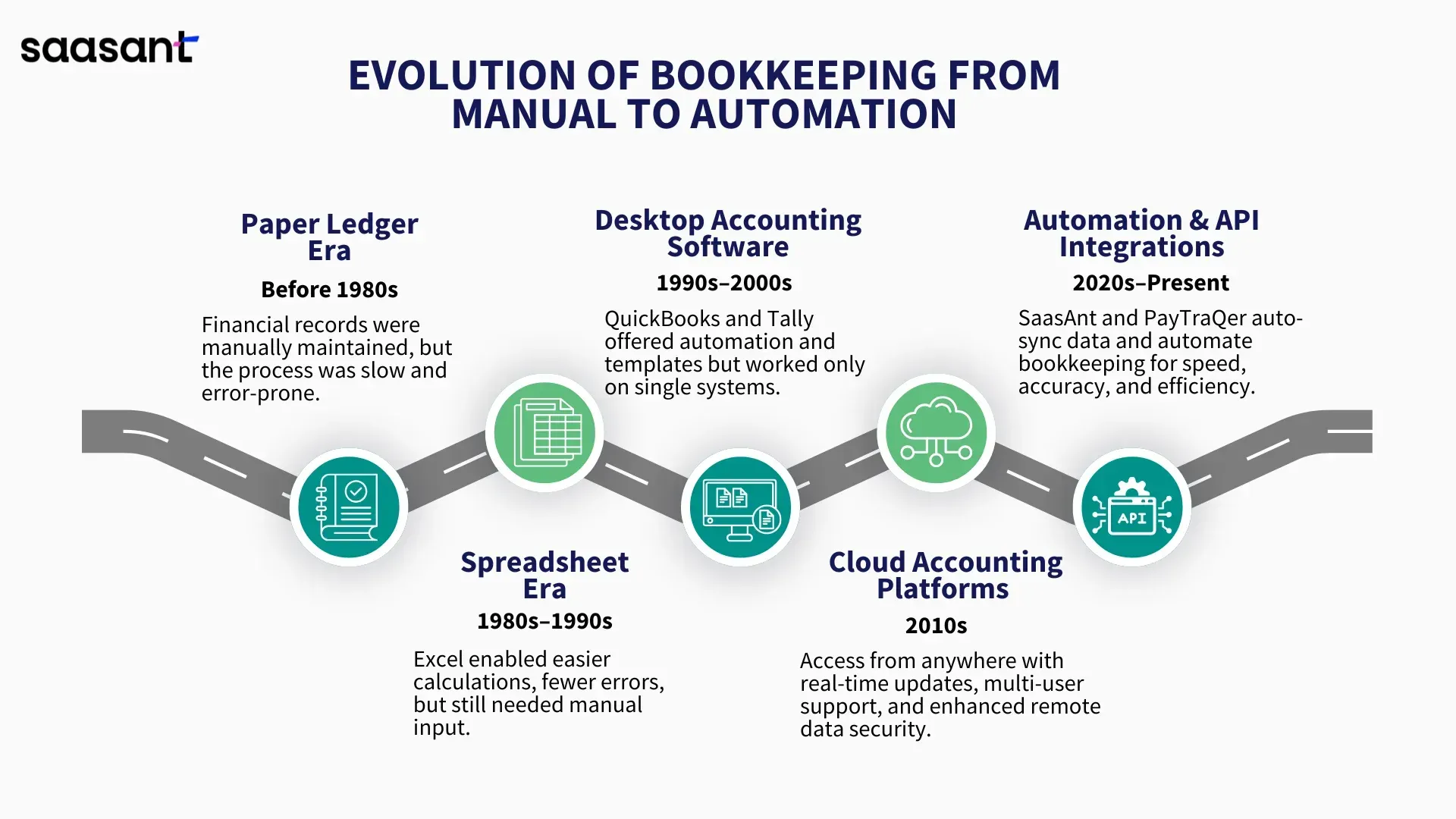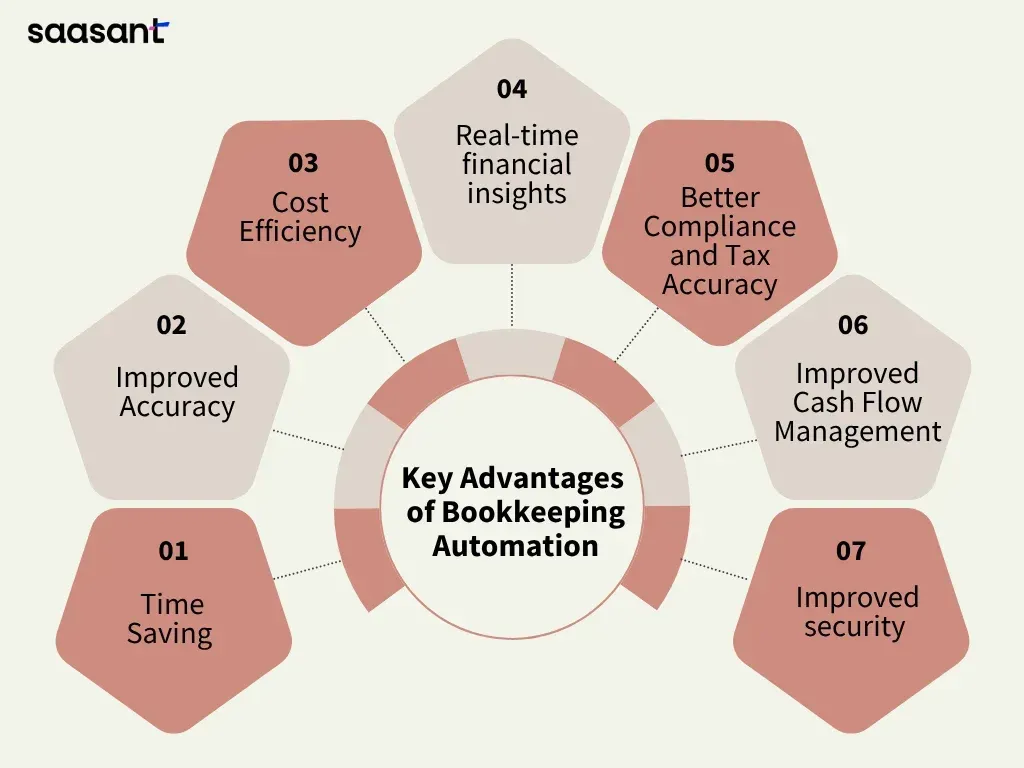Bookkeeping Automation vs Manual Bookkeeping: A Comprehensive Comparison
Traditional bookkeeping has been a standard method of managing financial records, relying on handwritten ledgers, spreadsheets, and manual data entry.
In recent years, many businesses have begun to adopt bookkeeping automation. By using digital tools that connect with banks, payment gateways, and accounting software, they can automatically record, categorize, and reconcile transactions. This shift reflects the increasing demand for accuracy, efficiency, and real-time financial visibility.
This blog discusses the evolution of bookkeeping from manual methods to automation, outlines the significant differences, and explains how tools like SaasAnt help to simplify and optimize the process. It is best suited for small business owners, accountants, and finance professionals who are exploring more efficient, accurate, and scalable alternatives to traditional bookkeeping through modern automation tools.
Contents
What Is Manual Bookkeeping?
What Is Bookkeeping Automation?
Evolution of Bookkeeping: From Manual to Automation
Bookkeeping Automation vs Manual Bookkeeping - Detailed Comparison
Key Advantages of Bookkeeping Automation
When to Switch to Automation
How SaasAnt Simplifies Bookkeeping Automation
Wrap Up
Frequently Asked Questions
What Is Manual Bookkeeping?
A manual bookkeeping system is a traditional method for manually documenting a business's financial transactions. It involves the use of physical books, journals, and spreadsheets to manage income, expenses, and other financial records. Although this method offers a level of familiarity and control, it often becomes time-consuming, fallible, and challenging to manage as a business expands.
What Is Bookkeeping Automation?
Bookkeeping automation leverages technologies such as robotic process automation (RPA), artificial intelligence (AI), and machine learning (ML) to streamline tasks like data entry, invoicing, and financial reporting. It reduces errors, improves accuracy, and saves time by automating repetitive tasks. The primary advantages include real-time financial insights, cost reductions, and enhanced efficiency. Common areas for automation include categorizing bank transactions, managing invoices, processing payments, and generating reports. Tools like QuickBooks, Xero, and NetSuite are widely used for these purposes.
Evolution of Bookkeeping: From Manual to Automation

Bookkeeping has undergone significant advancements since the days of paper-based ledgers and manual entries. Initially, companies maintained their financial records manually, relying on physical books to track income, expenses, and account balances. Although this method was straightforward, it was time-consuming and prone to errors.
With the advent of personal computers came spreadsheets, such as Microsoft Excel, which helped organize financial data, perform calculations, and minimize errors. Later on, accounting software such as QuickBooks and Tally enabled a significant change. These tools offered beneficial features, such as automated calculations and templates, simplifying bookkeeping for small and medium-sized businesses.
With the advancement of technology, cloud-based accounting platforms became available, allowing users to access financial information at any time and from any location. These platforms provide real-time updates, support for multiple users, and improved security features.
Today, bookkeeping has advanced with the integration of APIs and new fintech tools. These advancements enable effortless data sharing between banks, payment gateways, and accounting software, helping businesses automate transaction entry, categorization, and reconciliation, which leads to smarter, quicker, and more accurate bookkeeping.
Bookkeeping Automation vs Manual Bookkeeping - Detailed Comparison
Feature | Manual Bookkeeping | Bookkeeping Automation |
Data Entry | Entries in ledgers and journals can be manual, handwritten, or typed. | Automatically retrieved from bank feeds, payment gateways, and invoices. |
Speed | Slower, requires manual calculations and data processing. | Quicker, automated computations and data handling. |
Accuracy | Susceptible to mistakes, errors in calculations, and data entry issues. | Decreases errors via system checks and data validations. |
Scalability | Tough to scale up, demands more employees and resources as the company grows. | Handles large transaction volumes with ease. |
Accessibility | Needs to be done in person; uses paper or local files. | Cloud-based, available from any location that has internet access |
Integration | Hard to connect with other tools, mainly independent. | Easily connects with banks, payroll, CRM, and accounting software. |
Data Storage & Security | Tangible records are at risk of being lost or damaged; storage capacity is limited. | Digital storage that includes backups provides extensive capacity and advanced security features. |
Audit Trails | Tracking transactions can be challenging. | Offers transparent audit trails for effortless tracking. |
Reporting | Reports are compiled manually and may be subject to delays. | Reports can be accessed as needed and are updated in real time. |
Cost | Low initial cost | Initial expenses are greater, due to subscription or software costs, but you will save money over time. |
Also Read: Easy Bookkeeping for Small Business: A Practical Guide to Streamlined Finances
Key Advantages of Bookkeeping Automation

1) Time Saving
Automation significantly accelerates tasks such as transaction recording, reconciliation, and reporting. This enables finance teams to concentrate on more strategic activities rather than routine bookkeeping tasks.
2) Improved Accuracy
Automated systems reduce human errors by checking data and highlighting inconsistencies, ensuring dependable financial records and compliance with accounting regulations.
3) Cost Efficiency
Automation reduces operational costs by minimizing labor requirements, resulting in long-term savings, although there may be initial or subscription costs associated with the automation tools.
4) Real-time financial insights
Automated systems provide real-time financial insights and reports to businesses, enabling them to make quicker and more informed decisions.
5) Better Compliance and Tax Accuracy
Bookkeeping automation enhances the accuracy of financial records by reducing manual errors and maintaining data organization and up-to-date status. It helps businesses meet compliance standards with clear audit trails and timely reports. It also streamlines tax calculations and filings, reducing the risk of penalties and improving overall accuracy during tax season.
6) Improved Cash Flow Management
Automating bookkeeping enhances cash flow management by providing real-time insights into cash positions, streamlining payment processing, and generating accurate forecasts. This enables companies to make quick decisions, prevent liquidity problems, and establish more defined strategies for future expansion.
7) Improved security
Cloud-based bookkeeping automation safeguards financial data through encryption, secure backups, and controlled access, thereby protecting sensitive information and ensuring that only authorized individuals can view or edit it.
When to Switch to Automation
Increasing transaction volume makes manual data entry difficult to manage.
Excessive time is spent on repetitive tasks, such as data entry, reconciliation, and report preparation.
Use of multiple platforms complicates manual updates for sales, payments, and banking.
Financial reports are often delayed or inaccurate, which can hinder timely decision-making.
Preparation for audits, tax season, or funding requires cleaner and more organized records.
Your team is stretched thin and requires tools to enhance efficiency without increasing manual workload.
How SaasAnt Simplifies Bookkeeping Automation
SaasAnt makes bookkeeping easier and automates the most time-consuming bookkeeping tasks, making financial management much more efficient for businesses, accountants, and bookkeepers.
Bulk Data Import: Easily import thousands of transactions (invoices, expenses, journal entries) from Excel or CSV files with minimal effort.
Custom Field Mapping: Set up field mappings to align with your accounting system once, allowing for template reuse in future uploads to enhance efficiency.
Smart Validations: Identify and fix errors before importing, helping maintain clean and accurate books.
Easy Export & Delete: Simplified bulk export and deletion of records to streamline data management and cleanup processes.
Support for Complex Use Cases: Flexibility to manage multi-line items, custom tax fields, and various transaction types effectively.
PayTraQer Integration: Automatic synchronization of transactions from payment gateways like Stripe, PayPal, and Square into QuickBooks or Xero, including fees and refunds.
Also Read: Save Time on Bookkeeping and Improve Margins with PayTraQer
Wrap Up
Manual bookkeeping, while once effective, has become a bottleneck for growing businesses. On the other hand, bookkeeping automation offers faster processing, greater accuracy, and real-time visibility into your financial data. It helps streamline repetitive tasks, reduce manual effort, and improve overall efficiency.
If your current bookkeeping is taking too much time or is difficult to manage, it may be a good time to consider automation. SaasAnt simplifies bookkeeping so you stay accurate, efficient, and audit-ready.
If you have inquiries regarding our products, features, trial, or pricing, or if you require a personalized demo, contact our team today. We are ready to assist you in discovering the ideal solution for your QuickBooks workflow.
Frequently Asked Questions
1) Is bookkeeping automation suitable for small businesses?
Indeed. Automation helps small businesses by minimizing repetitive tasks and ensuring their financial records are precise and up-to-date.
2) Can bookkeeping automation replace my accountant or bookkeeper?
No. It assists them by managing everyday tasks, allowing them to concentrate on strategy, reporting, and compliance.
Read Also
Attorney Bookkeeping with QuickBooks
Ecommerce Bookkeeping: Step-by-Step Guide
Construction Bookkeeping with QuickBooks: Master Your Projects
Contractor Bookkeeping Made Easy with QuickBooks